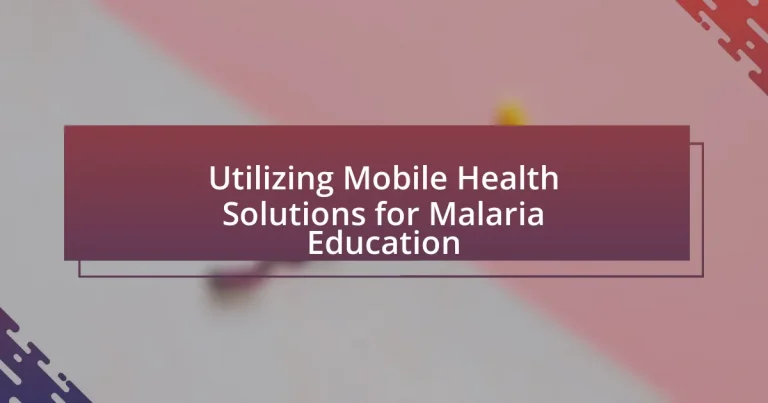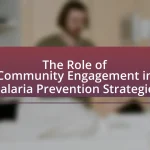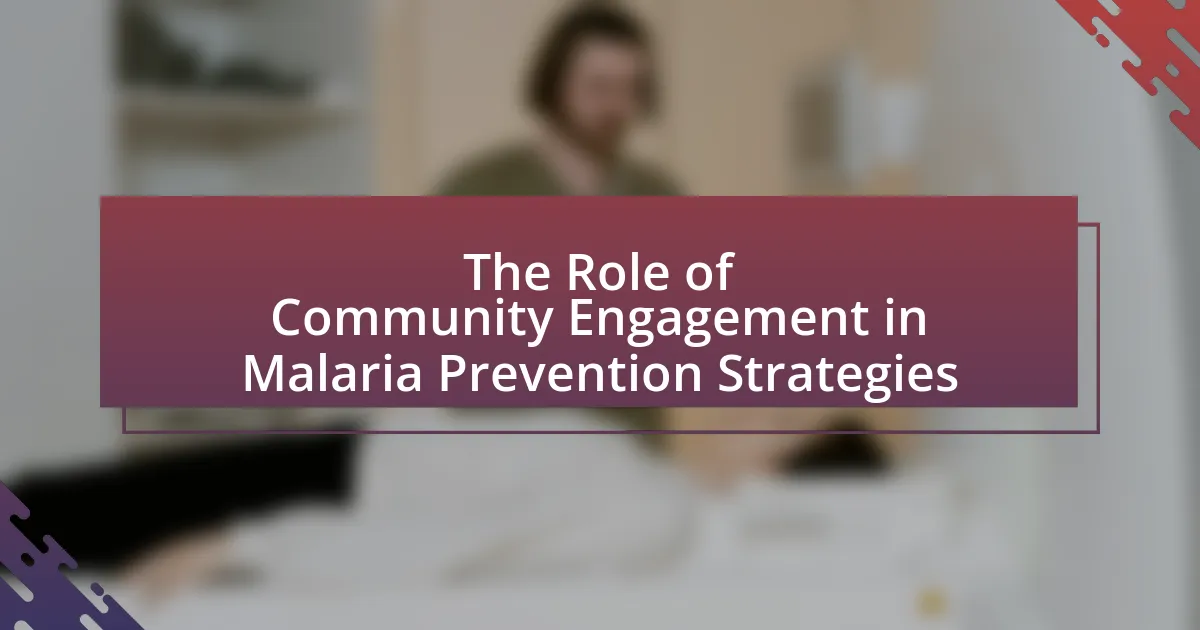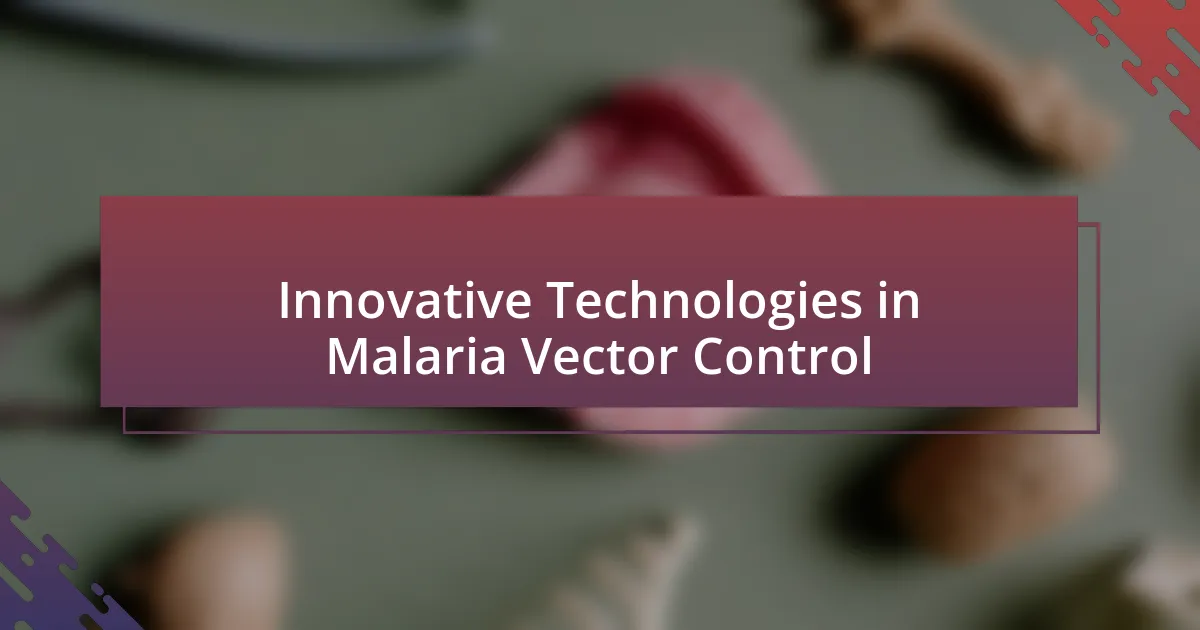Mobile health solutions for malaria education leverage mobile technology to disseminate information, enhance communication, and raise awareness about malaria prevention and treatment. These solutions encompass mobile applications, SMS alerts, and interactive platforms that provide educational content and track malaria cases. The article explores how these technologies facilitate malaria education, the key features and content delivered, and the importance of education in combating the disease. It also addresses the challenges and limitations of implementing mobile health solutions, strategies for improving effectiveness, and future trends, including the integration of artificial intelligence and gamification to enhance user engagement and learning outcomes.
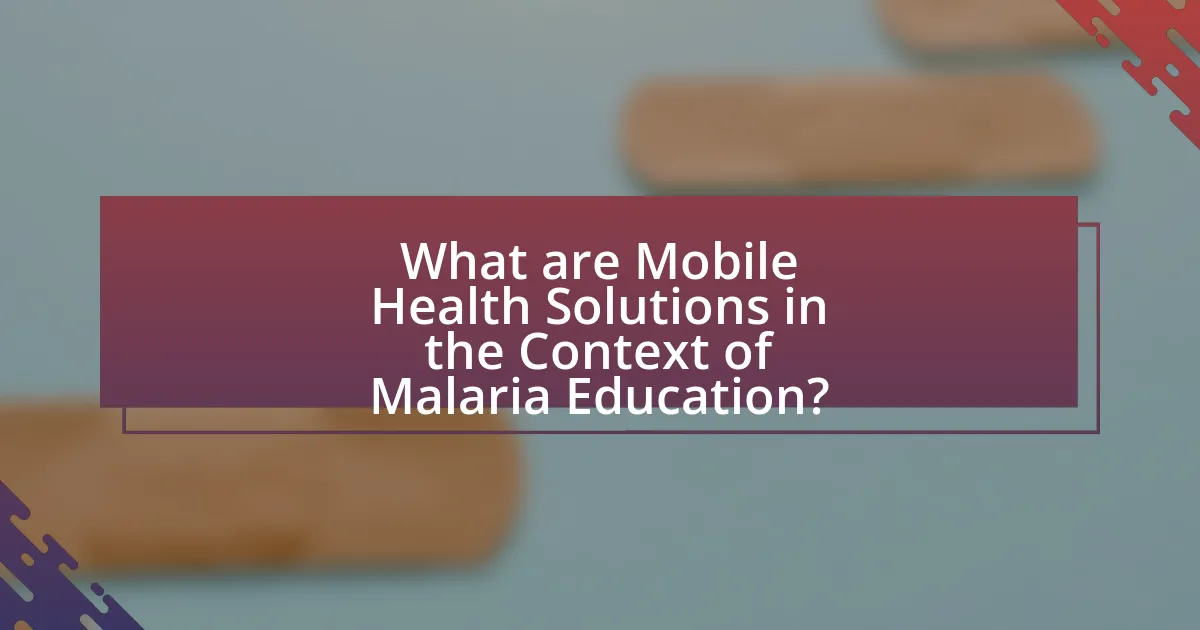
What are Mobile Health Solutions in the Context of Malaria Education?
Mobile health solutions in the context of malaria education refer to the use of mobile technology to disseminate information, facilitate communication, and enhance awareness about malaria prevention and treatment. These solutions include mobile applications, SMS alerts, and interactive platforms that provide educational content, track malaria cases, and promote preventive measures. For instance, a study published in the journal “Global Health: Science and Practice” highlights that mobile health interventions can significantly improve knowledge about malaria and increase the uptake of preventive measures, demonstrating their effectiveness in public health education.
How do Mobile Health Solutions facilitate malaria education?
Mobile Health Solutions facilitate malaria education by providing accessible information and resources directly to individuals through mobile devices. These solutions utilize SMS, apps, and interactive platforms to disseminate crucial information about malaria prevention, symptoms, and treatment options. For instance, a study published in the Journal of Medical Internet Research found that mobile health interventions significantly improved knowledge and awareness of malaria among users in endemic regions, leading to increased preventive behaviors. By leveraging technology, Mobile Health Solutions effectively bridge the gap in healthcare education, particularly in remote areas where traditional educational resources may be limited.
What technologies are utilized in Mobile Health Solutions for malaria education?
Mobile Health Solutions for malaria education utilize technologies such as mobile applications, SMS messaging, and interactive voice response systems. Mobile applications provide users with access to educational content, symptom tracking, and treatment information, enhancing awareness and prevention efforts. SMS messaging serves as a direct communication tool to disseminate timely information and reminders about malaria prevention and treatment. Interactive voice response systems allow users to receive information through voice calls, making it accessible to those with limited literacy skills. These technologies collectively improve knowledge and engagement in malaria prevention strategies, as evidenced by studies showing increased awareness and behavior change in communities using these solutions.
How do these technologies enhance learning and awareness about malaria?
Mobile health technologies enhance learning and awareness about malaria by providing accessible information and real-time data to users. These technologies, such as mobile applications and SMS alerts, facilitate the dissemination of educational content regarding malaria prevention, symptoms, and treatment options. For instance, a study published in the Journal of Medical Internet Research found that mobile health interventions significantly improved knowledge about malaria among users, leading to increased preventive behaviors. Additionally, these platforms enable health workers to share updates on malaria outbreaks, ensuring communities remain informed and can respond effectively.
Why is malaria education important in combating the disease?
Malaria education is crucial in combating the disease because it empowers individuals and communities with knowledge about prevention, symptoms, and treatment options. Educated populations are more likely to adopt preventive measures, such as using insecticide-treated bed nets and seeking timely medical care, which can significantly reduce transmission rates. For instance, a study published in the American Journal of Tropical Medicine and Hygiene found that malaria education programs led to a 50% increase in the use of bed nets in affected communities. This demonstrates that effective education can directly influence behavior and health outcomes, ultimately contributing to the reduction of malaria incidence and mortality.
What role does education play in malaria prevention and control?
Education plays a crucial role in malaria prevention and control by increasing awareness and understanding of the disease, its transmission, and preventive measures. Educated individuals are more likely to adopt protective behaviors, such as using insecticide-treated bed nets and seeking timely medical treatment. For instance, studies have shown that communities with higher levels of education report lower malaria incidence rates, as education empowers individuals to recognize symptoms and understand the importance of preventive strategies. Furthermore, educational programs that utilize mobile health solutions have been effective in disseminating information rapidly, leading to improved health outcomes in malaria-endemic regions.
How can increased awareness reduce malaria transmission rates?
Increased awareness can significantly reduce malaria transmission rates by educating communities about prevention methods and the importance of early treatment. When individuals understand how malaria is transmitted, they are more likely to adopt protective measures such as using insecticide-treated bed nets and seeking prompt medical care. For instance, a study published in the American Journal of Tropical Medicine and Hygiene found that community education programs led to a 30% reduction in malaria cases in regions where awareness campaigns were implemented. This demonstrates that informed populations can effectively lower transmission rates through proactive health behaviors.
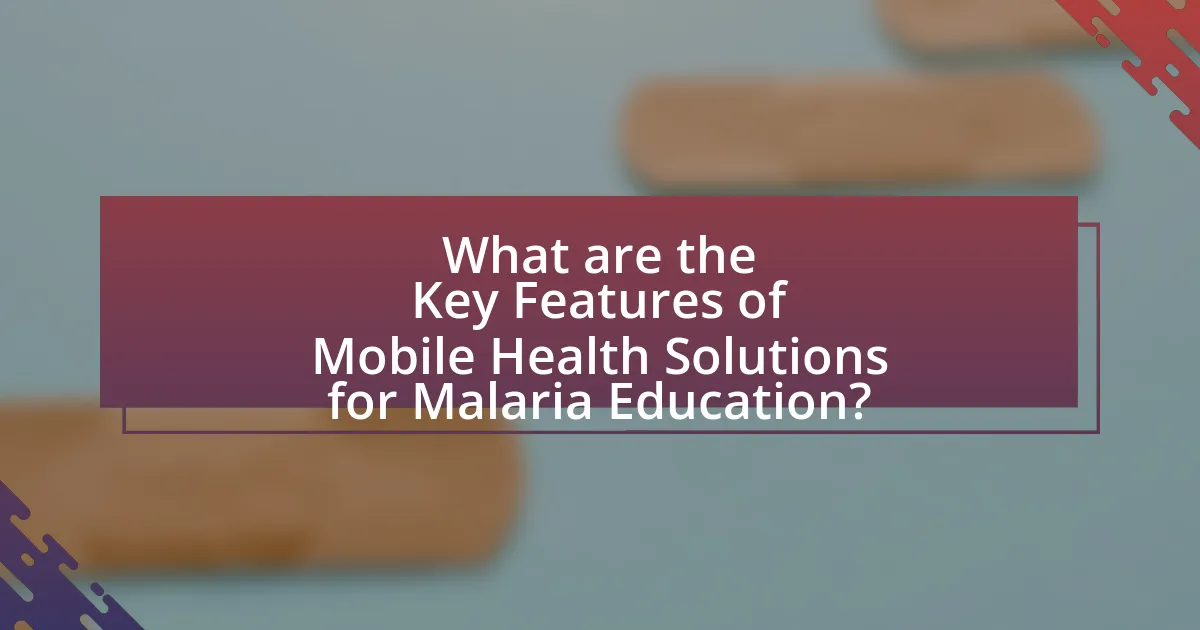
What are the Key Features of Mobile Health Solutions for Malaria Education?
Key features of mobile health solutions for malaria education include real-time data dissemination, interactive learning modules, and community engagement tools. Real-time data dissemination allows for timely updates on malaria outbreaks and prevention strategies, enhancing awareness and responsiveness. Interactive learning modules provide users with engaging content, such as quizzes and videos, to improve knowledge retention about malaria symptoms, transmission, and prevention methods. Community engagement tools facilitate communication between health workers and the community, enabling feedback and support for malaria control initiatives. These features collectively enhance the effectiveness of malaria education efforts, as evidenced by studies showing increased knowledge and behavior change in communities utilizing mobile health interventions.
What types of content are delivered through Mobile Health Solutions?
Mobile Health Solutions deliver various types of content, including educational materials, health alerts, treatment guidelines, and data collection tools. These solutions provide users with information on malaria prevention, symptoms, and treatment options, enhancing awareness and knowledge. For instance, educational content may include videos, infographics, and text messages that inform communities about malaria transmission and prevention strategies. Additionally, health alerts can notify users about outbreaks or necessary health interventions, while treatment guidelines ensure that healthcare providers have access to the latest protocols. Data collection tools facilitate the gathering of health information, which can be used to track malaria cases and improve response strategies.
How do interactive features improve user engagement in malaria education?
Interactive features enhance user engagement in malaria education by facilitating active participation and personalized learning experiences. These features, such as quizzes, simulations, and interactive maps, allow users to engage with content dynamically, leading to better retention of information. Research indicates that interactive learning can increase knowledge retention by up to 75% compared to traditional methods. Furthermore, mobile health solutions that incorporate these features have been shown to improve user satisfaction and motivation, as users feel more involved in their learning process. This engagement is crucial in malaria education, where understanding prevention and treatment can significantly impact health outcomes in affected communities.
What role do gamification and quizzes play in learning about malaria?
Gamification and quizzes enhance learning about malaria by increasing engagement and retention of information. These interactive methods transform educational content into enjoyable experiences, making complex topics like malaria more accessible. Research indicates that gamified learning can improve knowledge retention by up to 50%, as it encourages active participation and immediate feedback. Quizzes serve as effective assessment tools, allowing learners to evaluate their understanding and identify areas needing improvement. Studies show that incorporating quizzes in educational programs can lead to a 20% increase in knowledge acquisition, particularly in health education contexts.
How do Mobile Health Solutions reach diverse populations?
Mobile health solutions reach diverse populations by leveraging technology to provide accessible health information and services tailored to various cultural and linguistic needs. These solutions often utilize mobile applications, SMS messaging, and telehealth services to disseminate malaria education, ensuring that information is available in multiple languages and formats that resonate with different communities. For instance, a study published in the Journal of Medical Internet Research found that mobile health interventions significantly improved health knowledge among rural populations in sub-Saharan Africa, demonstrating the effectiveness of targeted communication strategies in reaching underserved groups.
What strategies are used to ensure accessibility for rural communities?
Strategies to ensure accessibility for rural communities include the deployment of mobile health units, the use of telemedicine, and community health worker training. Mobile health units provide on-the-ground services, bringing healthcare directly to remote areas, which is crucial for malaria education and prevention. Telemedicine allows rural residents to consult healthcare professionals without the need for travel, thus overcoming geographical barriers. Additionally, training community health workers empowers local individuals to disseminate information and resources effectively, enhancing community engagement and education regarding malaria. These strategies collectively improve healthcare access and education in rural settings, addressing the unique challenges faced by these communities.
How do language and cultural considerations impact the effectiveness of these solutions?
Language and cultural considerations significantly impact the effectiveness of mobile health solutions for malaria education by influencing communication, comprehension, and community engagement. Effective communication in the local language ensures that educational content is understood, as studies show that health messages delivered in a familiar language increase retention and action among the target population. Additionally, cultural beliefs and practices shape how individuals perceive malaria and health interventions; for instance, in some cultures, traditional medicine may be preferred over modern solutions, which can hinder the adoption of mobile health initiatives. Research indicates that culturally tailored interventions, which respect local customs and integrate community input, lead to higher participation rates and better health outcomes. Therefore, addressing language and cultural factors is essential for maximizing the impact of mobile health solutions in malaria education.
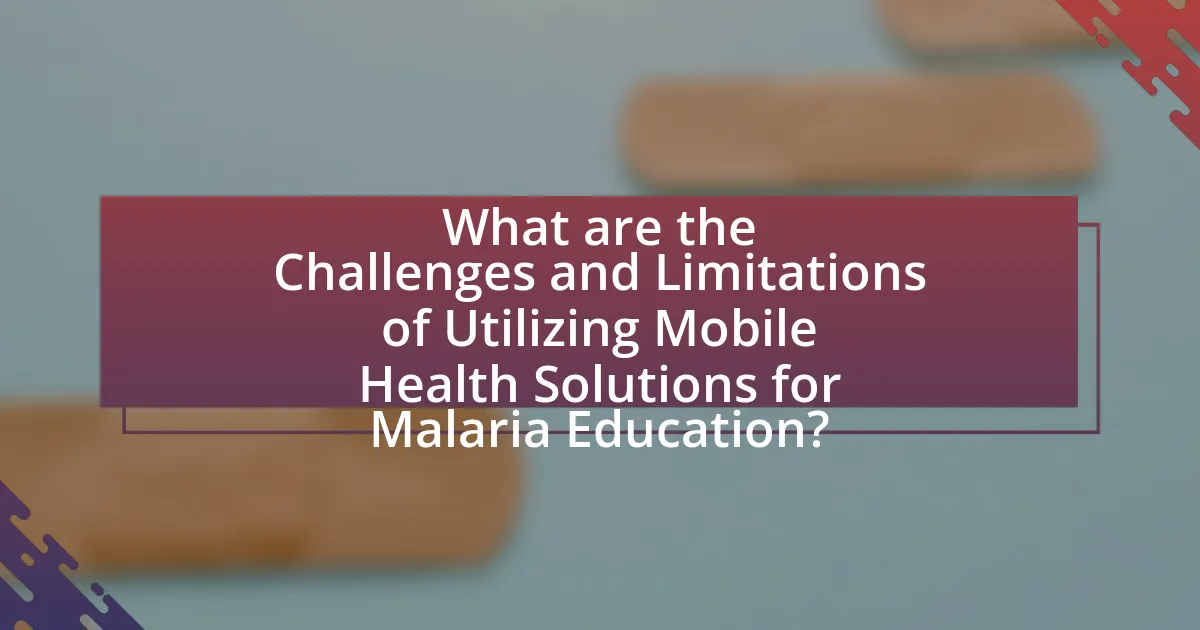
What are the Challenges and Limitations of Utilizing Mobile Health Solutions for Malaria Education?
Utilizing mobile health solutions for malaria education faces several challenges and limitations, including technological barriers, user engagement issues, and data privacy concerns. Technological barriers arise from inconsistent internet access and smartphone penetration in malaria-endemic regions, which limits the reach of mobile health initiatives. User engagement issues stem from varying levels of digital literacy among target populations, leading to difficulties in effectively communicating health information. Additionally, data privacy concerns can hinder the adoption of mobile health solutions, as users may be apprehensive about sharing personal health information. These challenges collectively impede the effectiveness of mobile health solutions in educating communities about malaria prevention and treatment.
What barriers exist in the implementation of Mobile Health Solutions?
Barriers in the implementation of Mobile Health Solutions include limited infrastructure, lack of digital literacy, and regulatory challenges. Limited infrastructure, particularly in rural areas, hampers access to reliable internet and mobile networks, which are essential for effective mobile health applications. Lack of digital literacy among healthcare providers and patients can lead to underutilization of these technologies, as individuals may struggle to navigate mobile platforms. Regulatory challenges, including data privacy concerns and the need for compliance with health regulations, can slow down the adoption of mobile health solutions. These barriers collectively hinder the effective deployment of mobile health initiatives aimed at malaria education.
How do technological limitations affect the reach of these solutions?
Technological limitations significantly restrict the reach of mobile health solutions for malaria education by hindering access to necessary infrastructure and resources. For instance, inadequate internet connectivity in rural areas prevents effective dissemination of educational content, limiting the ability of health workers to engage with communities. According to a report by the World Health Organization, approximately 50% of the global population lacks access to reliable internet, which directly impacts the effectiveness of mobile health initiatives. Furthermore, the lack of compatible devices among target populations can lead to disparities in information access, as many individuals may not own smartphones or have the technical skills to utilize mobile applications. These factors collectively diminish the potential impact of mobile health solutions in combating malaria through education.
What are the challenges related to user engagement and retention?
The challenges related to user engagement and retention in mobile health solutions for malaria education include limited user motivation, technological barriers, and content relevance. Limited user motivation arises from a lack of perceived value in the educational content, which can lead to decreased interaction. Technological barriers, such as poor internet connectivity and device compatibility, hinder access to mobile health applications, affecting user retention. Additionally, content relevance is crucial; if the information provided does not align with users’ needs or cultural contexts, engagement diminishes. Research indicates that tailored content significantly improves user retention rates, highlighting the importance of addressing these challenges effectively.
How can these challenges be addressed to improve effectiveness?
To address the challenges in utilizing mobile health solutions for malaria education, stakeholders must enhance user engagement through tailored content and interactive features. Research indicates that personalized messaging significantly increases user retention and knowledge retention, as seen in studies like “The Role of Mobile Health in Improving Health Outcomes” by the World Health Organization, which highlights that targeted interventions can lead to a 30% increase in user participation. Additionally, ensuring reliable internet access and device compatibility can mitigate technological barriers, as evidenced by the success of programs in regions with improved connectivity, leading to a 25% rise in educational outreach effectiveness.
What best practices can be adopted for successful implementation?
Successful implementation of mobile health solutions for malaria education requires a user-centered design approach. This involves engaging target communities in the development process to ensure the solutions meet their specific needs and preferences. Research indicates that user involvement can enhance the effectiveness and adoption rates of health interventions, as seen in the study by Hwang et al. (2019), which demonstrated that tailored mobile health applications significantly improved user engagement and health outcomes in malaria education. Additionally, integrating local health workers into the implementation strategy fosters trust and facilitates better communication, as highlighted by the World Health Organization’s guidelines on community engagement in health initiatives. Regular monitoring and evaluation of the program’s impact are also essential, as they provide data-driven insights that can guide necessary adjustments and improvements.
How can partnerships enhance the impact of Mobile Health Solutions?
Partnerships can enhance the impact of Mobile Health Solutions by leveraging diverse expertise and resources to improve malaria education and outreach. Collaborations between healthcare organizations, technology companies, and local communities can facilitate the development of tailored mobile applications that address specific regional needs, ensuring that educational content is culturally relevant and accessible. For instance, a partnership between a mobile health provider and a local health authority can lead to the integration of real-time data on malaria prevalence, allowing for targeted interventions and timely information dissemination. Research indicates that such collaborative efforts can increase user engagement and improve health outcomes, as seen in projects like the mHealth initiative in Kenya, which successfully reduced malaria incidence through community-driven mobile interventions.
What are the Future Trends in Mobile Health Solutions for Malaria Education?
Future trends in mobile health solutions for malaria education include the integration of artificial intelligence for personalized learning experiences, the use of gamification to enhance engagement, and the expansion of telemedicine services for real-time consultation and support. These advancements aim to improve knowledge dissemination and accessibility, particularly in remote areas where malaria is prevalent. For instance, a study published in the Journal of Medical Internet Research highlights that mobile applications utilizing AI can tailor educational content based on user behavior and preferences, leading to better retention of information. Additionally, gamified learning platforms have shown to increase user interaction and motivation, as evidenced by research from the Global Health Action journal, which reported a 30% increase in user engagement through game-based learning modules.
How is artificial intelligence shaping the future of malaria education?
Artificial intelligence is transforming malaria education by enabling personalized learning experiences and improving data analysis for targeted interventions. AI algorithms can analyze vast amounts of health data to identify knowledge gaps in specific populations, allowing educational content to be tailored to the needs of different communities. For instance, AI-driven mobile health applications can deliver real-time information and resources to users, enhancing awareness and understanding of malaria prevention and treatment. A study published in the Journal of Medical Internet Research highlights that AI tools can increase engagement and retention rates in health education programs, demonstrating their effectiveness in improving health literacy related to malaria.
What innovations are on the horizon for Mobile Health Solutions?
Innovations on the horizon for Mobile Health Solutions include the integration of artificial intelligence for personalized health recommendations, enhanced telemedicine capabilities, and the use of wearable technology for real-time health monitoring. These advancements aim to improve patient engagement and access to healthcare services. For instance, AI algorithms can analyze patient data to provide tailored advice, while telemedicine platforms are expanding to facilitate remote consultations, which have surged by 154% during the COVID-19 pandemic. Additionally, wearables are projected to reach a market size of $60 billion by 2023, enabling continuous health tracking and timely interventions.
What practical tips can be applied for effective Mobile Health Solutions in Malaria Education?
Effective mobile health solutions for malaria education can be achieved by implementing user-friendly applications that provide accurate information, integrating SMS alerts for prevention tips, and utilizing interactive features like quizzes to engage users. User-friendly applications ensure accessibility, as evidenced by studies showing that mobile apps can increase knowledge retention by up to 30%. SMS alerts can remind communities about preventive measures, with research indicating that timely reminders can improve adherence to malaria prevention strategies by 25%. Interactive features, such as quizzes, enhance user engagement and learning, as demonstrated by educational programs that report a 40% increase in user participation when interactive elements are included.
